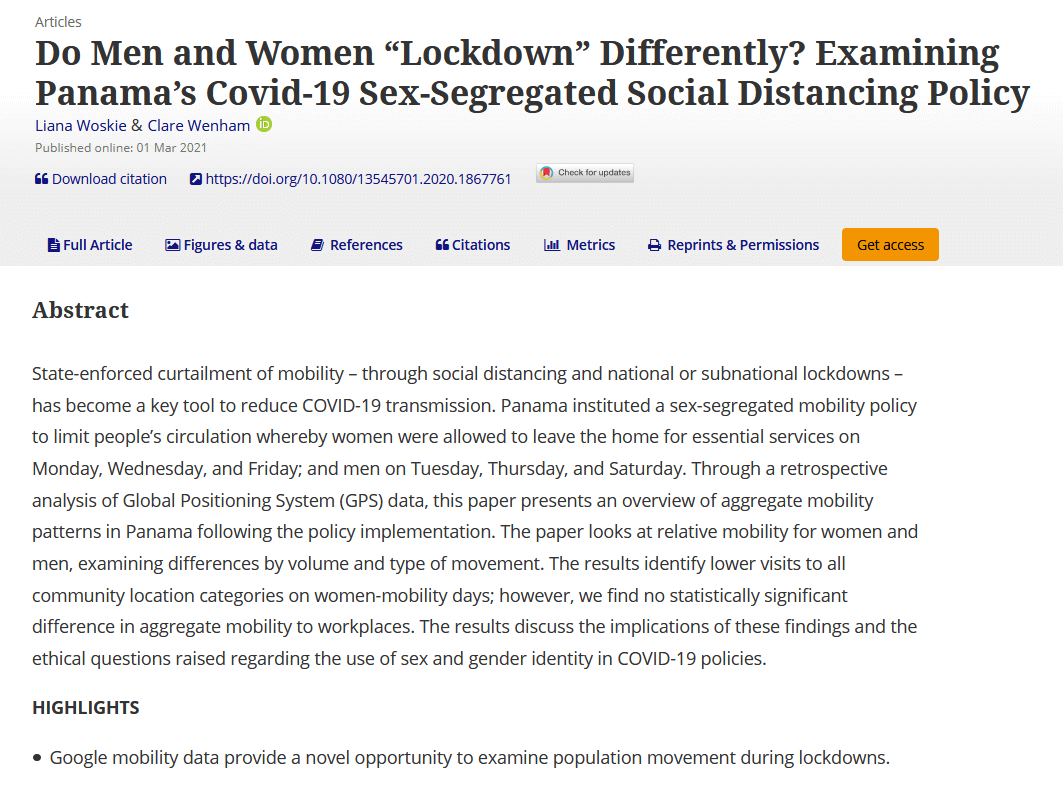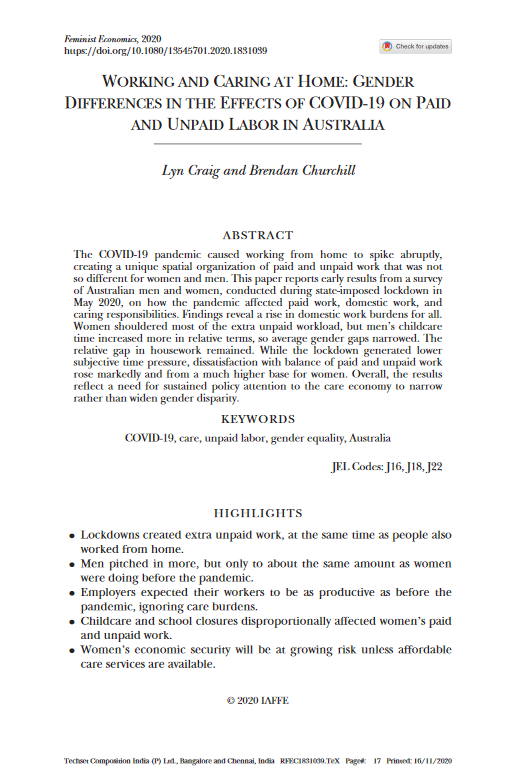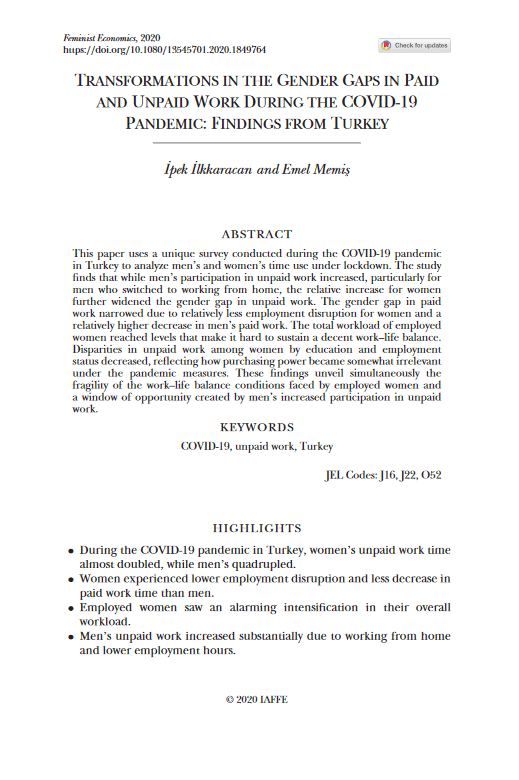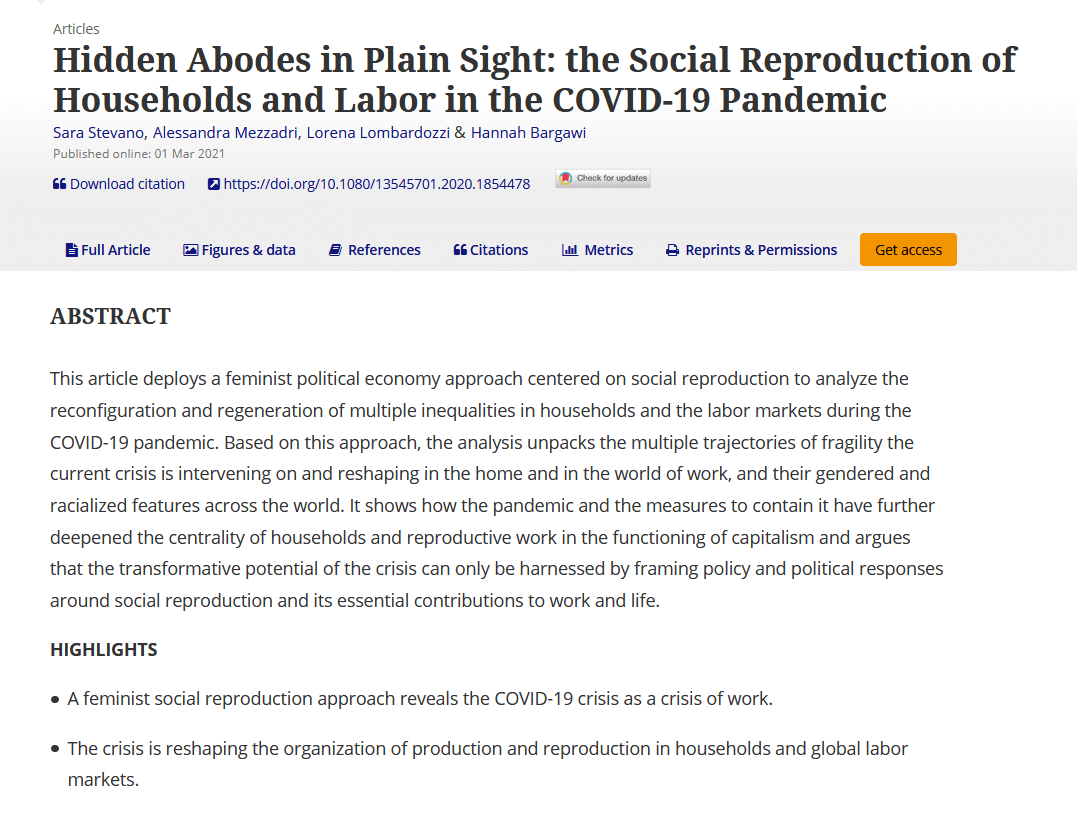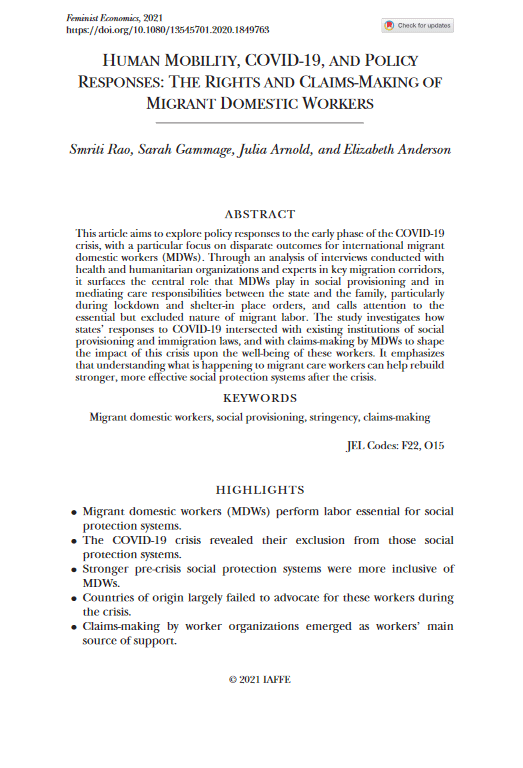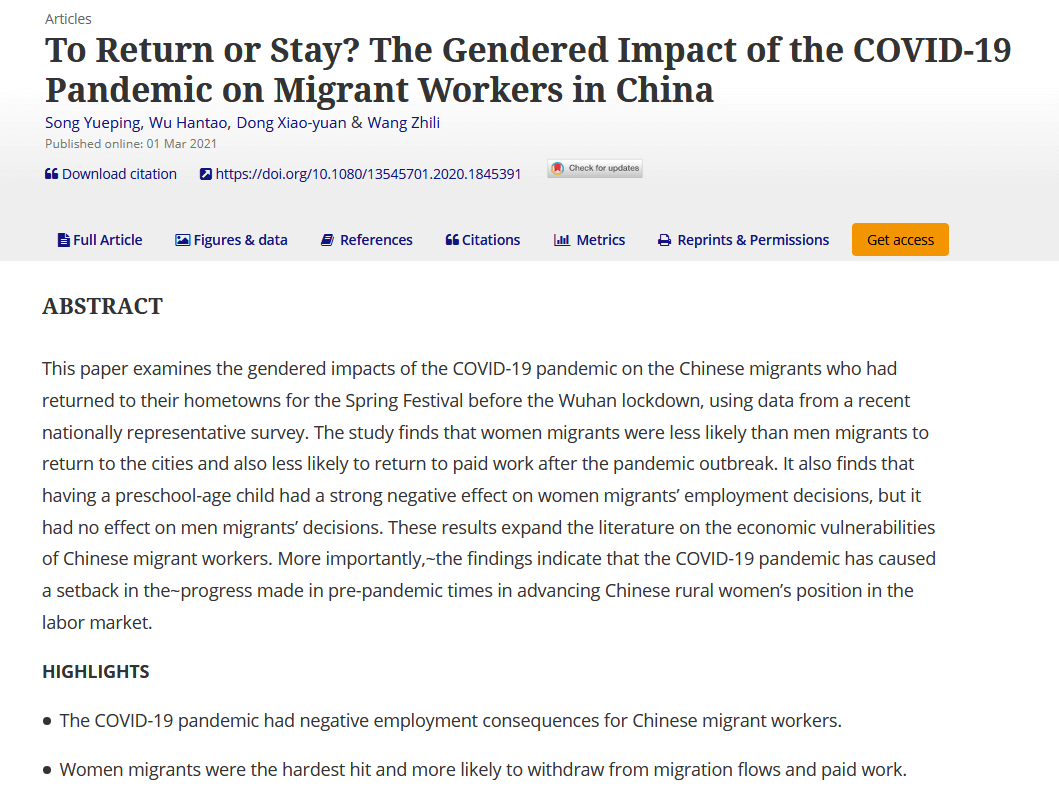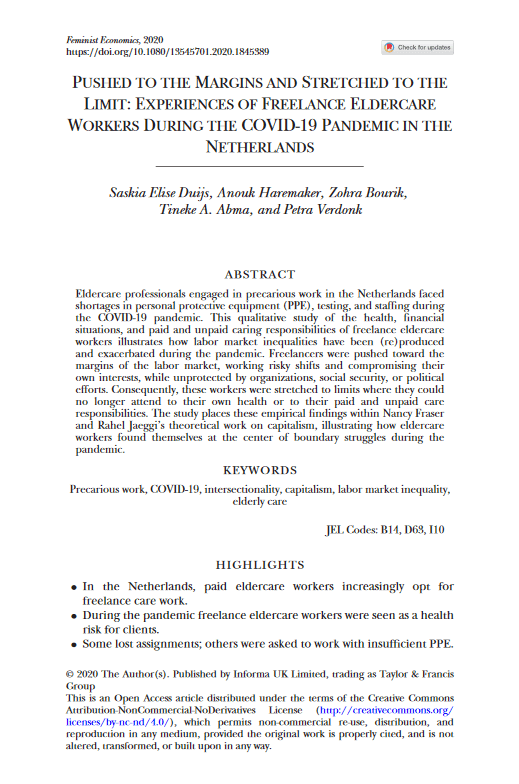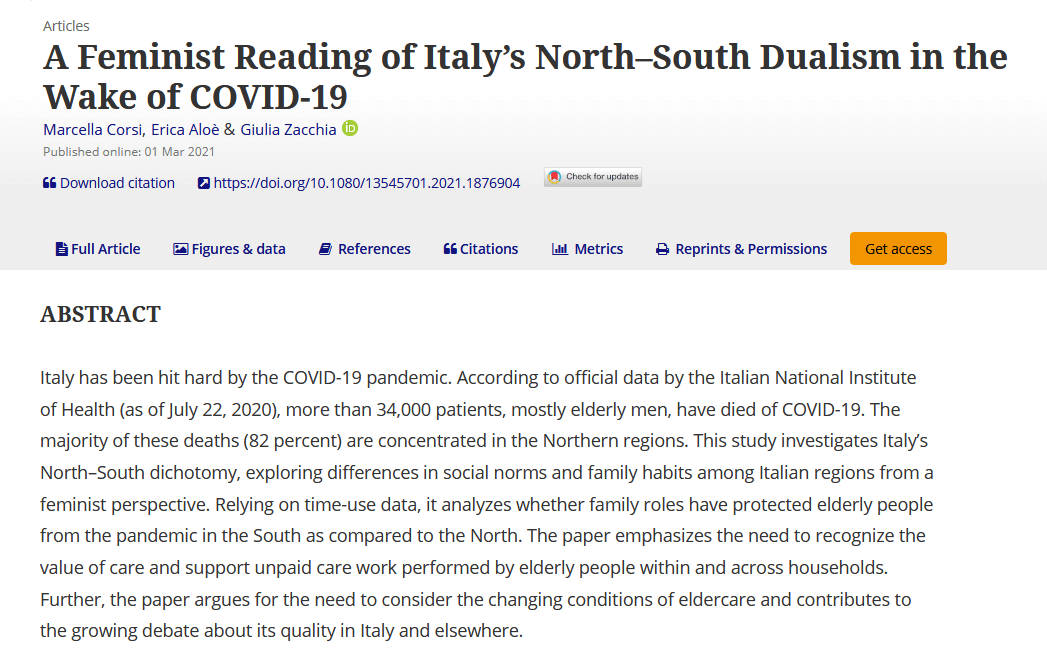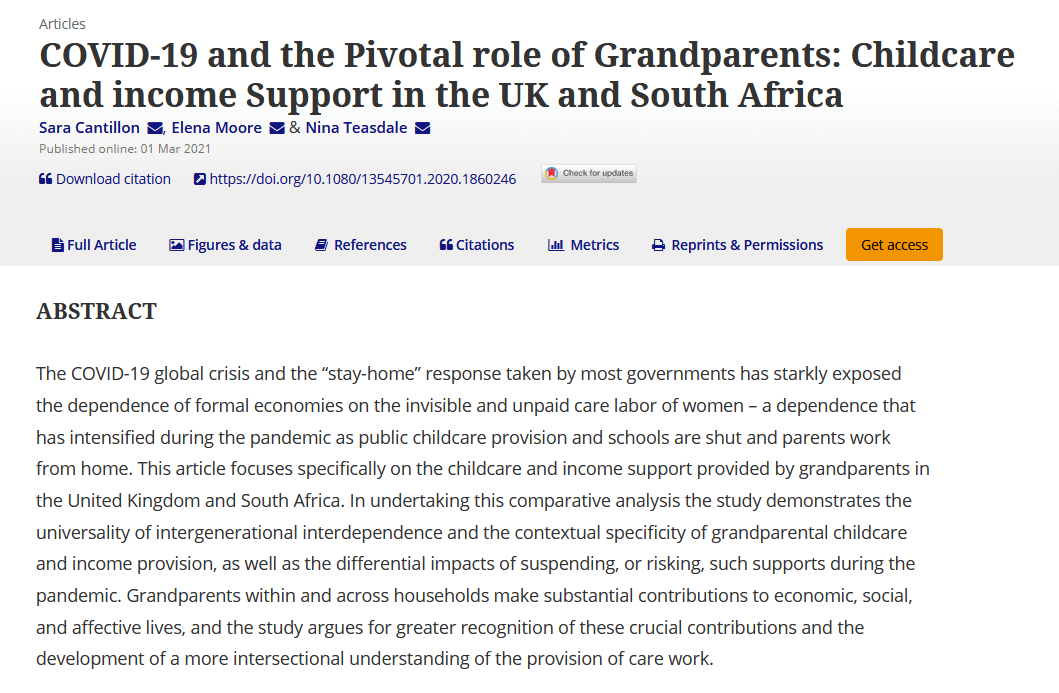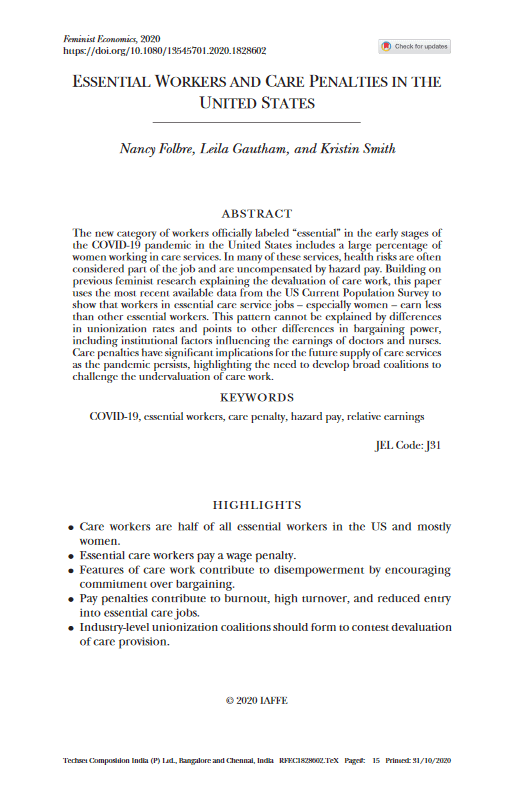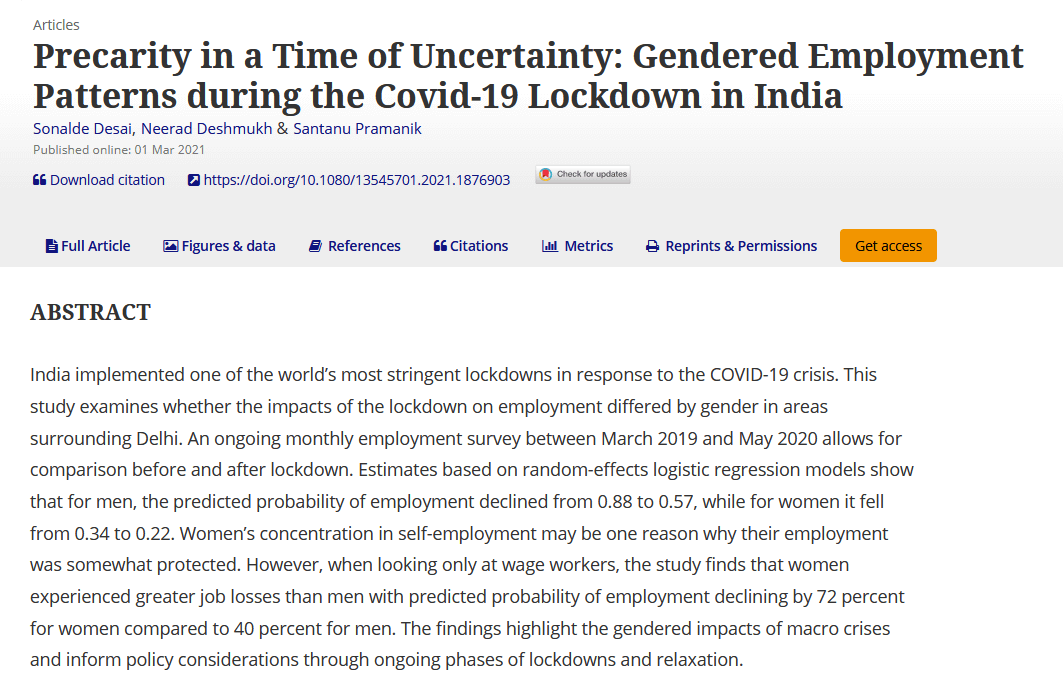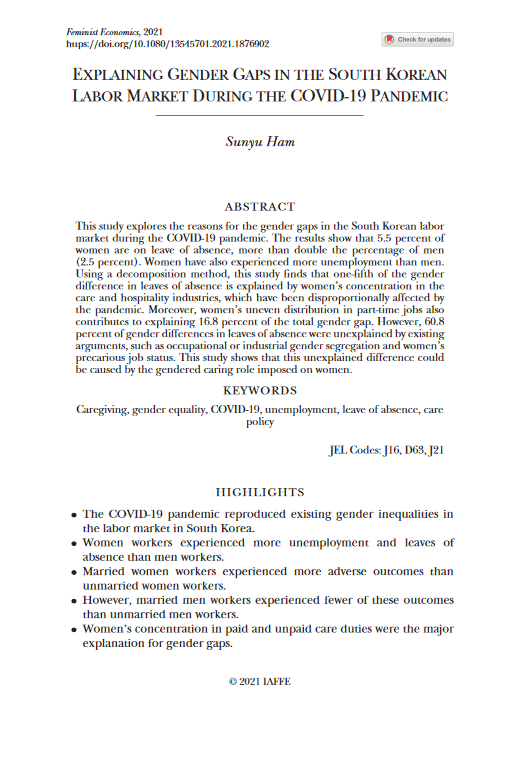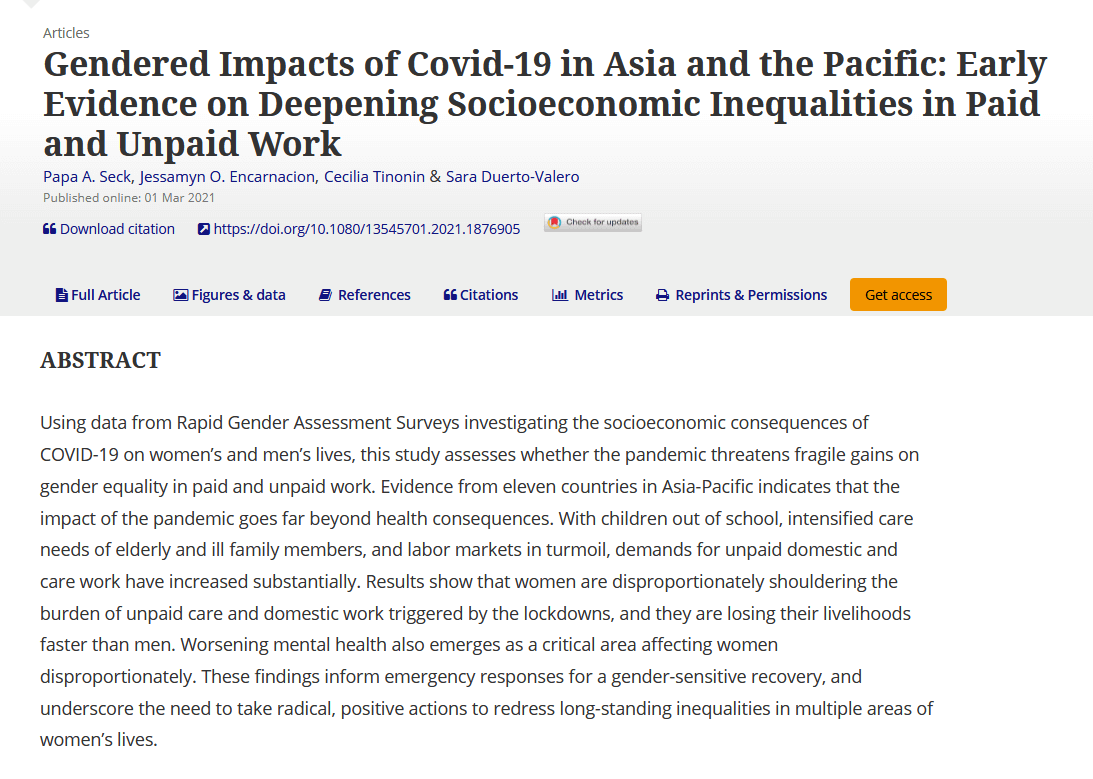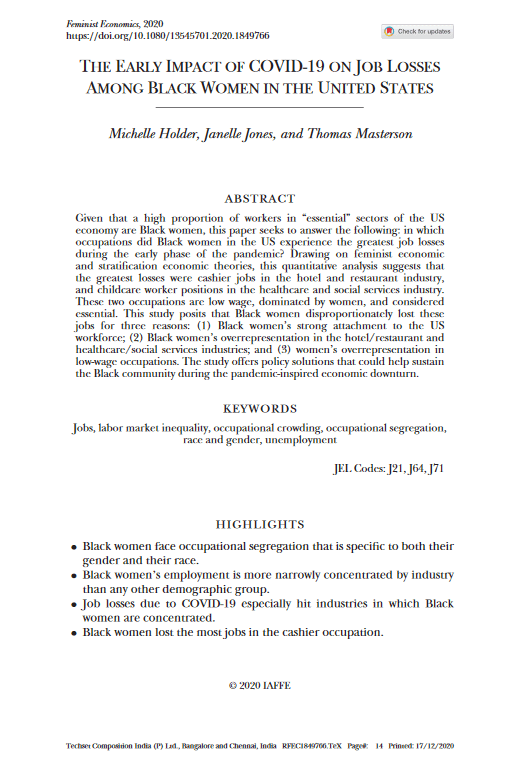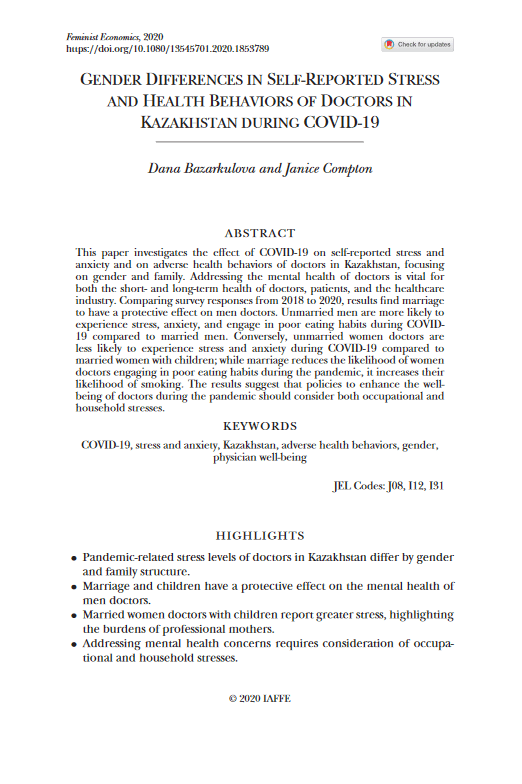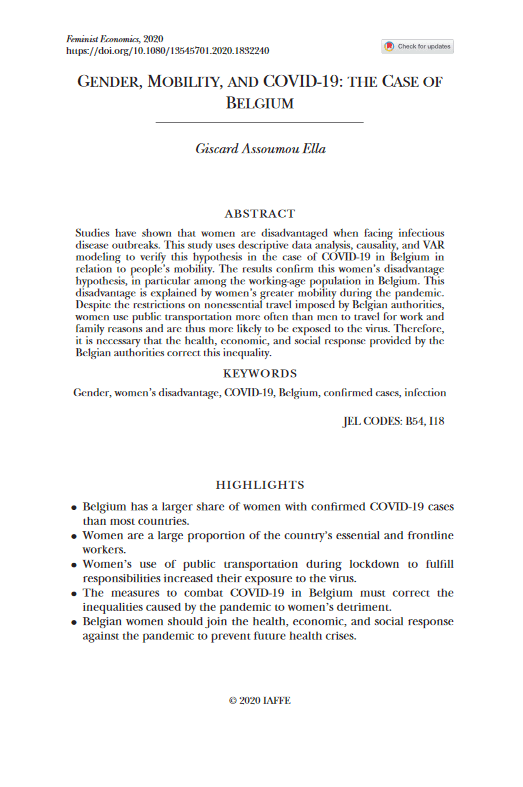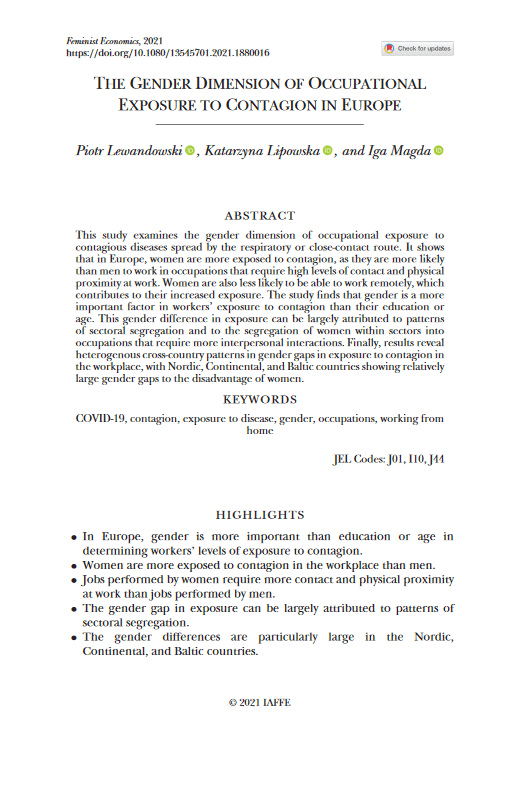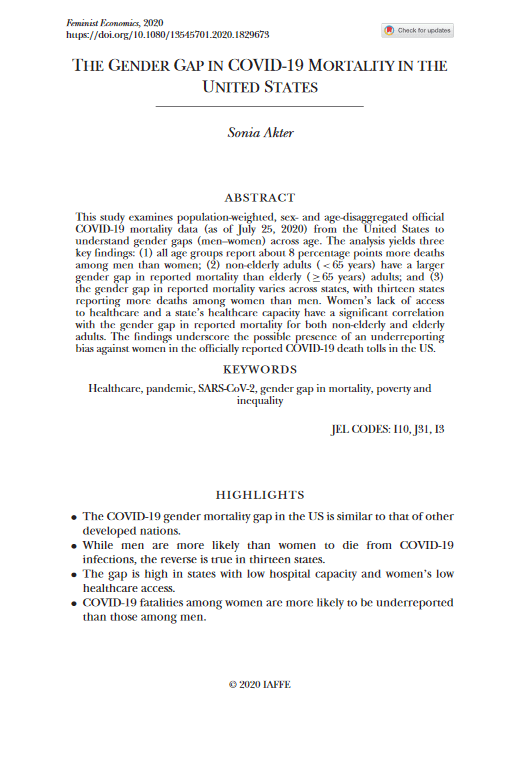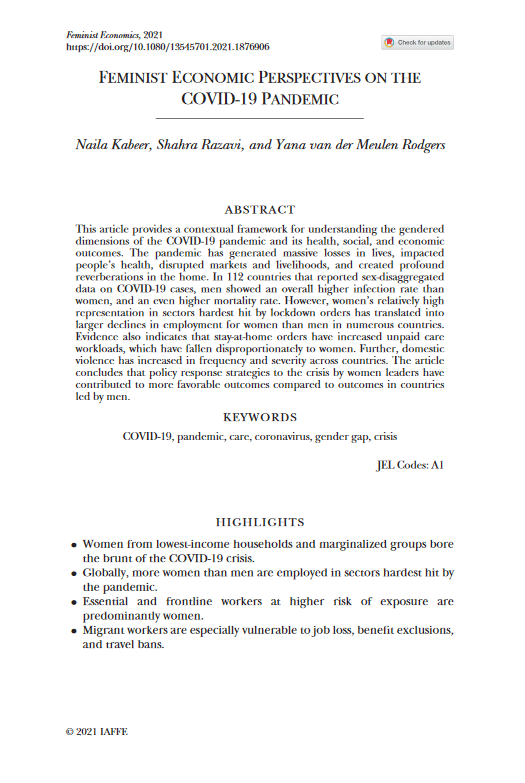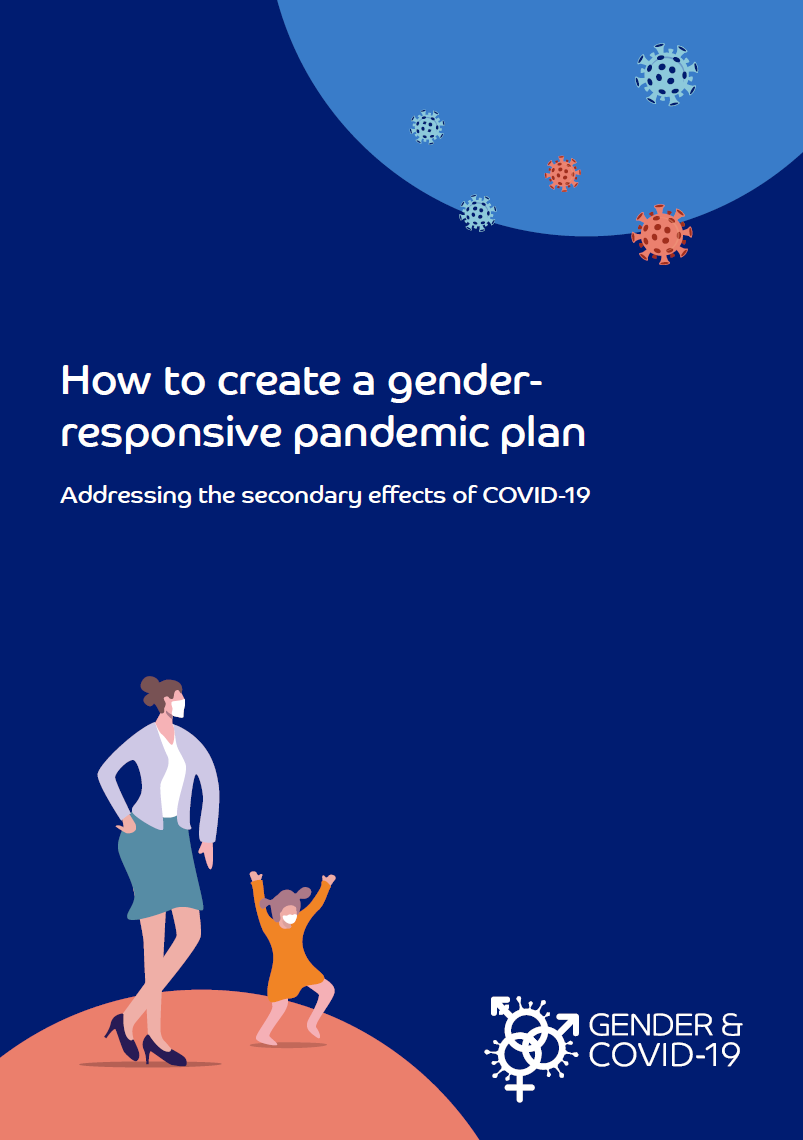Resources
![]()
This is a collection of resources from the Gender and Public Health Emergencies project and the Gender Working Group. You can search by year, country and type of resource. We hope you will enjoy reading this growing body of knowledge from around the world.
We have a wider collection of Gender and COVID-19 resources in this google document which is curated by Rosemary Morgan.
State-enforced curtailment of mobility – through social distancing and national or subnational lockdowns – has become a key tool to reduce COVID-19 transmission. Panama instituted a sex-segregated mobility policy to limit people’s circulation whereby women were allowed to leave the home for essential services on Monday, Wednesday, and Friday; and men on Tuesday, Thursday, and […]
The COVID-19 pandemic caused working from home to spike abruptly, creating a unique spatial organization of paid and unpaid work that was not so different for women and men. This paper reports early results from a survey of Australian men and women, conducted during state-imposed lockdown in May 2020, on how the pandemic affected paid […]
This paper uses a unique survey conducted during the COVID-19 pandemic in Turkey to analyze men’s and women’s time use under lockdown. The study finds that while men’s participation in unpaid work increased, particularly for men who switched to working from home, the relative increase for women further widened the gender gap in unpaid work. […]
This article deploys a feminist political economy approach centered on social reproduction to analyze the reconfiguration and regeneration of multiple inequalities in households and the labor markets during the COVID-19 pandemic. Based on this approach, the analysis unpacks the multiple trajectories of fragility the current crisis is intervening on and reshaping in the home and […]
This article aims to explore policy responses to the early phase of the COVID-19 crisis, with a particular focus on disparate outcomes for international migrant domestic workers (MDWs). Through an analysis of interviews conducted with health and humanitarian organizations and experts in key migration corridors, it surfaces the central role that MDWs play in social […]
This paper examines the gendered impacts of the COVID-19 pandemic on the Chinese migrants who had returned to their hometowns for the Spring Festival before the Wuhan lockdown, using data from a recent nationally representative survey. The study finds that women migrants were less likely than men migrants to return to the cities and also […]
Eldercare professionals engaged in precarious work in the Netherlands faced shortages in personal protective equipment (PPE), testing, and staffing during the COVID-19 pandemic. This qualitative study of the health, financial situations, and paid and unpaid caring responsibilities of freelance eldercare workers illustrates how labor market inequalities have been (re)produced and exacerbated during the pandemic. Freelancers […]
Italy has been hit hard by the COVID-19 pandemic. According to official data by the Italian National Institute of Health (as of July 22, 2020), more than 34,000 patients, mostly elderly men, have died of COVID-19. The majority of these deaths (82 percent) are concentrated in the Northern regions. This study investigates Italy’s North–South dichotomy, […]
The COVID-19 global crisis and the “stay-home” response taken by most governments has starkly exposed the dependence of formal economies on the invisible and unpaid care labor of women – a dependence that has intensified during the pandemic as public childcare provision and schools are shut and parents work from home. This article focuses specifically […]
The new category of workers officially labeled “essential” in the early stages of the COVID-19 pandemic in the United States includes a large percentage of women working in care services. In many of these services, health risks are often considered part of the job and are uncompensated by hazard pay. Building on previous feminist research […]
India implemented one of the world’s most stringent lockdowns in response to the COVID-19 crisis. This study examines whether the impacts of the lockdown on employment differed by gender in areas surrounding Delhi. An ongoing monthly employment survey between March 2019 and May 2020 allows for comparison before and after lockdown. Estimates based on random-effects […]
This study explores the reasons for the gender gaps in the South Korean labor market during the COVID-19 pandemic. The results show that 5.5 percent of women are on leave of absence, more than double the percentage of men (2.5 percent). Women have also experienced more unemployment than men. Using a decomposition method, this study […]
Given that a high proportion of workers in “essential” sectors of the US economy are Black women, this paper seeks to answer the following: in which occupations did Black women in the US experience the greatest job losses during the early phase of the pandemic? Drawing on feminist economic and stratification economic theories, this quantitative […]
This paper investigates the effect of COVID-19 on self-reported stress and anxiety and on adverse health behaviors of doctors in Kazakhstan, focusing on gender and family. Addressing the mental health of doctors is vital for both the short- and long-term health of doctors, patients, and the healthcare industry. Comparing survey responses from 2018 to 2020, […]
Studies have shown that women are disadvantaged when facing infectious disease outbreaks. This study uses descriptive data analysis, causality, and VAR modeling to verify this hypothesis in the case of COVID-19 in Belgium in relation to people’s mobility. The results confirm this women’s disadvantage hypothesis, in particular among the working-age population in Belgium. This disadvantage […]
This study examines the gender dimension of occupational exposure to contagious diseases spread by the respiratory or close-contact route. It shows that in Europe, women are more exposed to contagion, as they are more likely than men to work in occupations that require high levels of contact and physical proximity at work. Women are also […]
This study examines population-weighted, sex- and age-disaggregated official COVID-19 mortality data (as of July 25, 2020) from the United States to understand gender gaps (men–women) across age. The analysis yields three key findings: (1) all age groups report about 8 percentage points more deaths among men than women; (2) non-elderly adults (<65 years) have a […]
This article provides a contextual framework for understanding the gendered dimensions of the COVID-19 pandemic and its health, social, and economic outcomes. The pandemic has generated massive losses in lives, impacted people’s health, disrupted markets and livelihoods, and created profound reverberations in the home. In 112 countries that reported sex-disaggregated data on COVID-19 cases, men […]
This brief describes differences in the secondary economic, social, health, and security effects ofpandemics across genders. It aims to help decisionmakers to address gender disparities in pandemic preparedness, response, and recovery plans. The document outlines the process of creating a gender-responsive pandemic plan and priority areas for action; it also provides recommendations on partnership and […]
Resources
![]()
This is a collection of resources from the Gender and COVID-19 project and the Gender Working Group. You can search by year, country and type of resource. We hope you will enjoy reading this growing body of knowledge from around the world.
We have a wider collection of Gender and COVID-19 resources in this google document which is curated by Rosemary Morgan.
State-enforced curtailment of mobility – through social distancing and national or subnational lockdowns – has become a key tool to reduce COVID-19 transmission. Panama instituted a sex-segregated mobility policy to limit people’s circulation whereby women were allowed to leave the home for essential services on Monday, Wednesday, and Friday; and men on Tuesday, Thursday, and […]
The COVID-19 pandemic caused working from home to spike abruptly, creating a unique spatial organization of paid and unpaid work that was not so different for women and men. This paper reports early results from a survey of Australian men and women, conducted during state-imposed lockdown in May 2020, on how the pandemic affected paid […]
This paper uses a unique survey conducted during the COVID-19 pandemic in Turkey to analyze men’s and women’s time use under lockdown. The study finds that while men’s participation in unpaid work increased, particularly for men who switched to working from home, the relative increase for women further widened the gender gap in unpaid work. […]
This article deploys a feminist political economy approach centered on social reproduction to analyze the reconfiguration and regeneration of multiple inequalities in households and the labor markets during the COVID-19 pandemic. Based on this approach, the analysis unpacks the multiple trajectories of fragility the current crisis is intervening on and reshaping in the home and […]
This article aims to explore policy responses to the early phase of the COVID-19 crisis, with a particular focus on disparate outcomes for international migrant domestic workers (MDWs). Through an analysis of interviews conducted with health and humanitarian organizations and experts in key migration corridors, it surfaces the central role that MDWs play in social […]
This paper examines the gendered impacts of the COVID-19 pandemic on the Chinese migrants who had returned to their hometowns for the Spring Festival before the Wuhan lockdown, using data from a recent nationally representative survey. The study finds that women migrants were less likely than men migrants to return to the cities and also […]
Eldercare professionals engaged in precarious work in the Netherlands faced shortages in personal protective equipment (PPE), testing, and staffing during the COVID-19 pandemic. This qualitative study of the health, financial situations, and paid and unpaid caring responsibilities of freelance eldercare workers illustrates how labor market inequalities have been (re)produced and exacerbated during the pandemic. Freelancers […]
Italy has been hit hard by the COVID-19 pandemic. According to official data by the Italian National Institute of Health (as of July 22, 2020), more than 34,000 patients, mostly elderly men, have died of COVID-19. The majority of these deaths (82 percent) are concentrated in the Northern regions. This study investigates Italy’s North–South dichotomy, […]
The COVID-19 global crisis and the “stay-home” response taken by most governments has starkly exposed the dependence of formal economies on the invisible and unpaid care labor of women – a dependence that has intensified during the pandemic as public childcare provision and schools are shut and parents work from home. This article focuses specifically […]
The new category of workers officially labeled “essential” in the early stages of the COVID-19 pandemic in the United States includes a large percentage of women working in care services. In many of these services, health risks are often considered part of the job and are uncompensated by hazard pay. Building on previous feminist research […]
India implemented one of the world’s most stringent lockdowns in response to the COVID-19 crisis. This study examines whether the impacts of the lockdown on employment differed by gender in areas surrounding Delhi. An ongoing monthly employment survey between March 2019 and May 2020 allows for comparison before and after lockdown. Estimates based on random-effects […]
This study explores the reasons for the gender gaps in the South Korean labor market during the COVID-19 pandemic. The results show that 5.5 percent of women are on leave of absence, more than double the percentage of men (2.5 percent). Women have also experienced more unemployment than men. Using a decomposition method, this study […]
Given that a high proportion of workers in “essential” sectors of the US economy are Black women, this paper seeks to answer the following: in which occupations did Black women in the US experience the greatest job losses during the early phase of the pandemic? Drawing on feminist economic and stratification economic theories, this quantitative […]
This paper investigates the effect of COVID-19 on self-reported stress and anxiety and on adverse health behaviors of doctors in Kazakhstan, focusing on gender and family. Addressing the mental health of doctors is vital for both the short- and long-term health of doctors, patients, and the healthcare industry. Comparing survey responses from 2018 to 2020, […]
Studies have shown that women are disadvantaged when facing infectious disease outbreaks. This study uses descriptive data analysis, causality, and VAR modeling to verify this hypothesis in the case of COVID-19 in Belgium in relation to people’s mobility. The results confirm this women’s disadvantage hypothesis, in particular among the working-age population in Belgium. This disadvantage […]
This study examines the gender dimension of occupational exposure to contagious diseases spread by the respiratory or close-contact route. It shows that in Europe, women are more exposed to contagion, as they are more likely than men to work in occupations that require high levels of contact and physical proximity at work. Women are also […]
This study examines population-weighted, sex- and age-disaggregated official COVID-19 mortality data (as of July 25, 2020) from the United States to understand gender gaps (men–women) across age. The analysis yields three key findings: (1) all age groups report about 8 percentage points more deaths among men than women; (2) non-elderly adults (<65 years) have a […]
This article provides a contextual framework for understanding the gendered dimensions of the COVID-19 pandemic and its health, social, and economic outcomes. The pandemic has generated massive losses in lives, impacted people’s health, disrupted markets and livelihoods, and created profound reverberations in the home. In 112 countries that reported sex-disaggregated data on COVID-19 cases, men […]
This brief describes differences in the secondary economic, social, health, and security effects ofpandemics across genders. It aims to help decisionmakers to address gender disparities in pandemic preparedness, response, and recovery plans. The document outlines the process of creating a gender-responsive pandemic plan and priority areas for action; it also provides recommendations on partnership and […]
